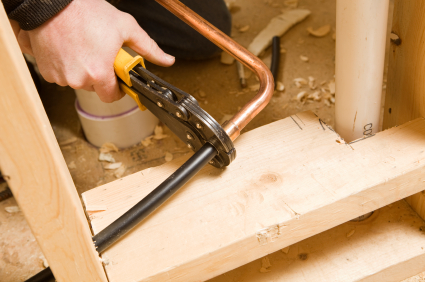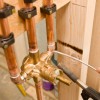Domestic Water Piping
Domestic water piping supplies water to the water heater and to all fixtures within a building. Common domestic water piping materials include copper, CPVC, and PEX tubing (cross-linked polymers). ABS plastic piping, galvanized steel, and black iron pipe were previously used in domestic water piping applications but are not currently approved under the 2009 International Building Code (IBC).

Topic Summary
Each type of piping material has its own characteristics, strengths and weaknesses, and applications. Lead used to be extensively installed in water piping systems but is banned today because of its tendency to infuse lead (a poison) into the water supply. Iron and galvanized steel piping may still be found in older homes, but copper, CPVC, and PEX tubing are currently the dominant materials used industry-wide. PVC is not allowed in domestic water supply piping, but it is used in waste piping applications.
Copper
 Copper will last a minimum of 50 years and is available in three basic types; Type M, Type L, and Type K. Different building codes may require different pipe types. Copper pipe designations have to do with the strength of the pipes.
Copper will last a minimum of 50 years and is available in three basic types; Type M, Type L, and Type K. Different building codes may require different pipe types. Copper pipe designations have to do with the strength of the pipes.
- Type M is a thin-walled pipe. It is the most common type of copper pipe sold and is used mainly behind walls inside homes to route water from the service line and water heater to the fixtures. Trunk lines are typically run in 3/4" type M copper with 1/2" type M branching to serve individual fixtures.
- Type L (hard or soft) is a thicker-walled pipe and is considered standard piping for water services both inside and out. Wherever copper piping will be exposed, type L should be used.
- Type K (hard or soft) is the thickest-walled pipe and is used mainly between water mains and the meter, for heavy-duty vacuum pump lines, and underground lines.
Copper will generally not interact with the water it carries. However, copper should not be connected to black steel. If this connection is unavoidable, then a properly sized dielectric coupling or fastener must be installed. This coupler separates the two metals so that they do not come into contact with each other. When this occurs, what is known as galvanic action takes place, and both pipes rot. For this same reason, water heaters should have dielectric couplers because water heaters are usually steel while the piping is copper.
CPVC
CPVC is a popular choice in domestic water piping applications due to its cost savings over metal piping such as copper. It is also lighter than copper pipe, which leads to faster installations (extra care should be taken to ensure piping does not sag during installation). CPVC is installed with a solvent cement, which also adds to faster installation times when compared to copper because soldering is not needed. Additional advantages of CPVC pipe are its immunity to corrosion, resistance to scale buildup, and its freedom from electrolysis (due to CPVC's plastic composition).
PEX
 PEX tubing is a viable solution to the rising cost of water supply piping installation because it is less expensive and easier to install than copper. Typical installations do not require elbows. Instead, the PEX tubing is simply bent around the corners with a smooth bend. PEX is also a forgiving product to work with. For example, if it should become kinked, applying heat locally to the kink will, in most cases, cause it to return to its original shape. Other advantages over copper and CPVC piping include resistance to scaling, chlorine, and corrosion, as well as no need for soldering.
PEX tubing is a viable solution to the rising cost of water supply piping installation because it is less expensive and easier to install than copper. Typical installations do not require elbows. Instead, the PEX tubing is simply bent around the corners with a smooth bend. PEX is also a forgiving product to work with. For example, if it should become kinked, applying heat locally to the kink will, in most cases, cause it to return to its original shape. Other advantages over copper and CPVC piping include resistance to scaling, chlorine, and corrosion, as well as no need for soldering.
Domestic Water Piping Considerations
In all cases, whether CPVC, PEX, or copper piping is used, the manufacturer’s recommendations should be followed. If copper piping is used, care must be taken to ensure that lead-free solder is used to connect the fittings with the piping.
Minimal maintenance is all that is required unless the piping is very old. If this is the case, then there could be blockages or restrictions in flow due to the buildup of deposits on the inside walls of the piping. CPVC and PEX are less likely to have deposits.
When the piping system no longer serves the building’s demands, or there are multiple failures, then the system should be considered for replacement. For a localized failure, simply replace the section that failed.

Buildipedia Staff
The Buildipedia research and writing staff consists of dozens of experienced professionals from many sectors of the industry, including architects, designers, contractors, and engineers.
Website: buildipedia.com/



